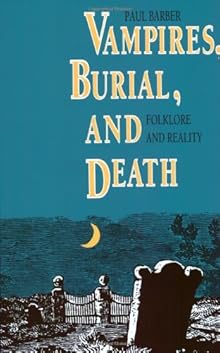Vampire Forensics: Uncovering the Origins of an Enduring Legend is by Mark Collins Jenkins, who is listed on the jacket flap as a National Geographic historian.
Boy, is National Geographic in trouble!
The book itself is an interesting enough read, but it’s mostly a rehash of stuff you can find elsewhere. It’s a Discovery Channel or History Channel digest of a much more involving and fascinating topic (viz., the origins of worldwide belief in vampires). That’s not necessarily an insult, but it is definitely NOT a great compliment.
This book really only spends a few pages dealing the topic suggested by the title. That is, putting the lore of vampirism under the medical microscope.
If you want to read an authoritative book about this, I cannot highly enough recommend Paul Barber’s Vampires, Burial, and Death: Folklore and Reality.
Barber’s book is the real deal, explaining how the actual behavior of corpses could have given rise to middle-European vampire legendry.
But if you are in the mood for the literary equivalent of Count Floyd explaining vampires (but without the silliness), read Jenkins’s book.
Here’s what I mean about National Geographic being in trouble.
The book contains several errors that SHOULD NOT APPEAR in this book, ESPECIALLY in a book by a supposed historian, and a book sponsored by National Geographic, supposedly an educational-type set-up.
On page 48, in his discussion of Stoker’s Dracula, Jenkins refers to the vampire version of Lucy Westenra as “the Blooper Lady.” DUH! Lucy was called by her child victims a “bloofer lady.” Bloofer (with an F) was Stoker’s representation of a Lucy’s child victims saying that she was beautiful. So, by using BLOOPER, Jenkins has committed a BLOOPER.
On pages 51-52, Jenkins narrates the controversy stirred by FW Murnau’s 1922 silent film Nosferatu, and Florence Stoker’s quest to have it eradicated. Jenkins says, “Bram Stoker had died in 1912, but when his widow, Florence, got wind of Murnau’s changes, she tried to shut the production down. Royalties from Dracula were her main income, and she found the German film a thinly disguised pirating of the novel. So she sued.”
Jenkins is correct that Florence Stoker sued, and that Dracula’s royalties were her main source of livelihood. But her legal action wasn’t because she got wind of “changes” to Stoker’s story being made in the production of an in-development film. Mrs Stoker DID NOT try “to shut the production down.” There was no production going on. No, Nosferatu was already made, and in distribution, when Mrs Stoker “got wind” of it. She wasn’t mad about “changes.” She was mad because, despite the changes, the film was indeed a “thinly disguised” version of SOME of Dracula’s plot. She wanted money (which wazs entitled to, as Stoker’s heir).
Horror fans everywhere are happy that some of the prints survived the court-ordered destruction.
On page 195, Jenkins gives an incorrect definition of theological dualism. He says that the Bogomil sect “was one in a long line of dualist religions – faiths that considered all matter as evil and revere all spirit as good.” Right word, wrong definition.
There is a branch of “philosophy of mind” called Dualism, that indeed relates to the relationship between mind and matter. However, the spiritual, or religious beliefs labeled “dualism” are concerned NOT with matter and non-matter, but with more primary forces. These powers may express themselves through matter, but are spiritual forces.
According to the Catholic Encyclopedia’s article on Dualism: “First, the name has been used to denote the religious or theological system which would explain the universe as the outcome of two eternally opposed and coexisting principles, conceived as good and evil, light and darkness, or some other form of conflicting powers. We find this theory widely prevalent in the East, and especially in Persia, for several centuries before the Christian Era.” http://www.newadvent.org/cathen/05169a.htm
So, Jenkins is using the incorrect definition of Dualism in his discussion of various European sects. But the main problem is that he is “informing” his less enlightened readers by defining theological Dualism – with a wrong definition!
On page 229, Jenkins draws an incorrect inference from the location of the Egyptian Pyramids. “Possessing the most elaborate funerary complex of them all, as the pyramids have reminded countless visitors, the Egyptians so purified, embalmed, mummified, memorialized, and mythologized their dead that surely they must have told tales of their occasional return.”
This is an common, though wrong, conclusion -- that the Pyramids’ primary function is to be giant mausolems. The pyramids do indeed remind visitors to Egypt of death, by their location, not through any actual use as centers of death. Not a single burial has ever been found to have taken place in an Egyptian pyramid. The pyramids were NOT tombs. They may have been astronomical markers, centers for ritual religion, and monuments to human vanity, but they were NOT tombs. Which is what Jenkins is implying here.
These bloofers (I mean BLOOPERS) show that National Geographic needs some historians to check up on their historians. If “little” errors like these get into print, how much else of the book can be trusted? Now, that’s perhaps an exaggeration.
But just because a book has a respectable implied endorsement, don’t simply trust what it tells you -- check for yourself!
So, this book doesn’t really add much to the scads of books already out there about vampires and the rise of vampire belief. I paid $5 for it, and you can buy it for less from Amazon. Feel free to peruse it, just don’t be impressed by the “credentials” prominently displayed on the cover.
As George Harrison said, “Think for yourself, for I won’t be there with you.”












No comments:
Post a Comment